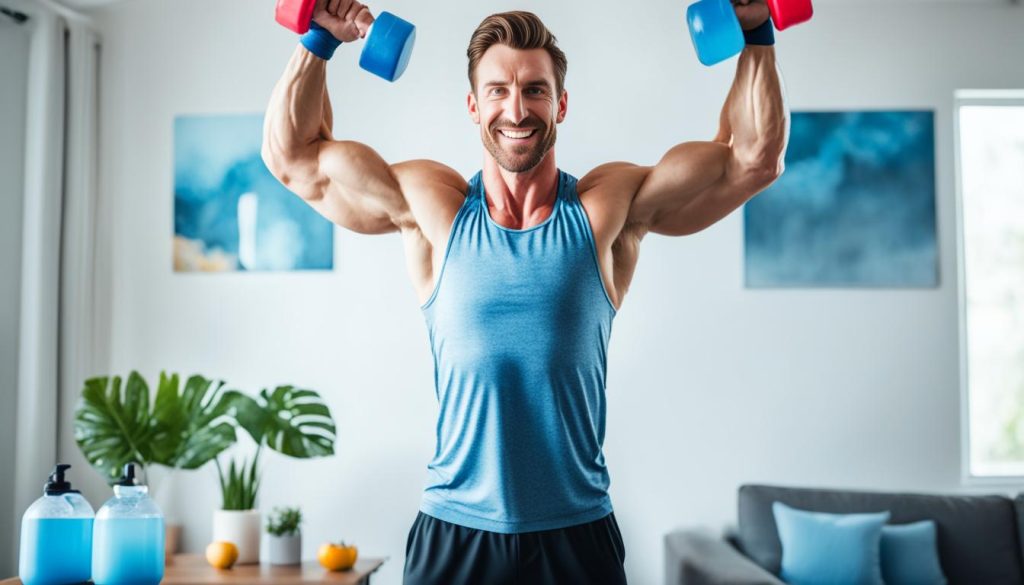Imagine a world where building muscle doesn’t need a pricey gym membership or lots of equipment. Your living room can turn into a place for training, and every spot can help shape your body. For many, life gets busy, leaving no time for the gym. This can make reaching your fitness goals feel impossible. But, what if you could build muscle at home with just your body and some creativity?
At-home strength training is easy to start and works well. You don’t need a lot of time or money to see changes. Using bodyweight exercises and a little gear can help you build strength and muscle. Whether it’s squeezing in a few minutes here and there or setting aside a half-hour, you can keep making progress. With the right workout plan and determination, you can get stronger at home.
Key Takeaways
- Low-load, high-volume resistance training can build muscle just as effectively as high-load methods.
- Incorporating plyometrics can stimulate muscle growth with high metabolic stress.
- Bodyweight exercises, such as push-ups and squats, require no equipment and can be done anywhere.
- HIIT can elevate your heart rate significantly, supporting effective muscle-building efforts.
- Short rest intervals can enhance muscle growth during workouts.
- Circuit training is an excellent option for an effective home workout.
- Consulting a fitness professional before starting can lead to safer, more effective training at home.
The Importance of Strength Training for Muscle Growth
Strength training is key for muscle growth and health. Doing at-home workouts twice a week can bring big benefits. It helps build lean muscle and cut down body fat.
One big plus of strength training is it makes you burn calories better. With more muscle, your body uses more calories, making it easier to manage weight. It also boosts metabolism, keeping your energy up all day.
Strength training does more than just grow muscles. It also makes bones stronger, more flexible, and improves how well you move. These benefits make life better, letting you do everyday tasks easily and lowering injury risks. For people with chronic issues like arthritis or heart disease, it can lessen symptoms and boost well-being.
A 2010 study found resistance bands work just as well as free weights or machines. This makes them a top choice for at-home workouts. So, you can keep up with your muscle health without a gym membership.
To wrap it up, adding strength training to your fitness plan is crucial. It helps keep muscle mass, strengthens bones, and boosts health. Regular resistance exercises help with muscle growth and improve both physical and mental health at any age.
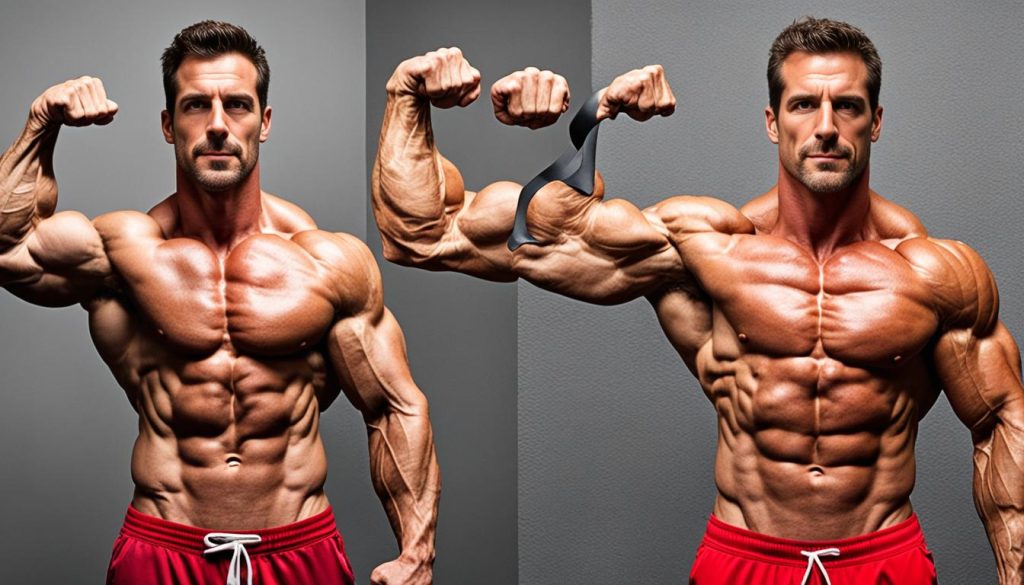
How Muscles Grow: Understanding Muscle Hypertrophy
Muscle hypertrophy means your muscles get bigger through different training methods. Knowing how it happens can make your workouts better. There are three main things that help muscles grow: mechanical tension, muscle damage, and metabolic stress. Each one plays a key role in muscle growth and how muscles react to exercise.
Mechanical Tension and Muscle Growth
Mechanical tension is the force muscles use when they contract against resistance. This tension is key for muscle growth and happens during exercises like squats and push-ups. Doing exercises that work big muscle groups at high intensity creates a lot of mechanical tension. This leads to more protein production in muscles.
Studies show that doing muscle-strengthening exercises at least twice a week helps muscle hypertrophy.
Muscle Damage and Microtrauma
Muscle damage, or microtrauma, happens when muscle fibers get small injuries during hard workouts. This damage starts the repair process, which can make muscles bigger and stronger. Mixing up exercises can increase muscle microtrauma, which helps muscles grow more.
Research points out that doing more sets of resistance exercises gives better results than just one set. This shows the value of a well-planned training routine for muscle damage and growth.
Metabolic Stress: A Pathway to Hypertrophy
Metabolic stress comes from the buildup of metabolic byproducts during long or hard exercise. This stress creates an environment that helps muscles grow. Using high-volume training with lighter weights can increase metabolic stress without needing heavy weights.
Eating about 20 grams of protein right after exercise can also help muscle protein synthesis. This boosts the effects of metabolic stress on muscle hypertrophy.
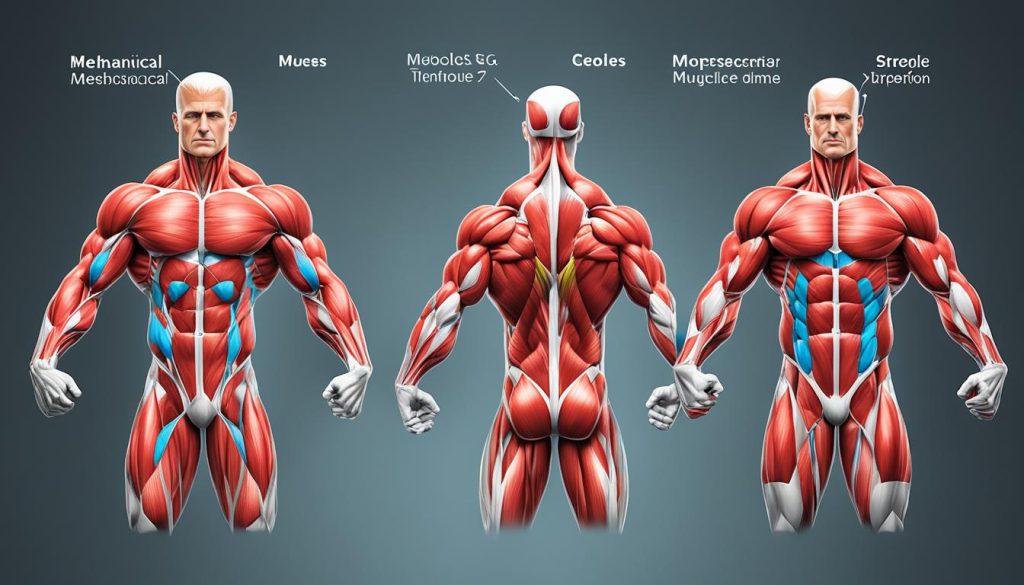
Build Muscle Without the Gym: At-Home Strength Training
Building muscle at home is now possible with at-home strength training. Many bodyweight workouts only need your weight and creativity. You can make big gains without going to a gym.
For beginners, start with bodyweight workouts two to three times a week. Include push-ups, squats, and lunges to work big muscles. Add 2 days of cardio to boost fitness and endurance.
At the novice level, try a split strength training plan of three to four days. This targets specific muscles each day. Advanced routines can go up to four to five days a week, focusing on high intensity.
Use different types of resistance in your workouts. Plyometrics and isometric holds are great without weights. Doing plank-ups and triceps dips can also boost arm strength with just your body.
At-home strength training is flexible. Resistance bands add variety and tension, making workouts more effective. They’re a great choice for those who don’t want to spend money on weights.

Your home can be your gym, showing that you can grow muscles with no gym required. It’s important to stay safe and informed to get the most out of your workouts and avoid injuries.
Essential Bodyweight Exercises for Building Muscle
Bodyweight exercises are a great way to get strong without gym gear. They help grow muscles by using your own weight to work different muscle groups. Here are three key exercises that help build strength: push-ups, squats, and pull-ups.
Push-Ups: A Comprehensive Chest Workout
Push-ups are a classic exercise that work the chest, shoulders, and triceps. Start in a plank position with your hands shoulder-width apart and feet together. Lower your body until your chest almost touches the ground, then push back up.
Variations like incline or decline push-ups offer different challenges for muscle growth.
Squats: Building Lower Body Strength
Squats are key for building strength in the lower body. They focus on the quads, hamstrings, and glutes. Stand with your feet shoulder-width apart and lower your body like you’re sitting in a chair, keeping your back straight.
Make sure your knees don’t go past your toes. For more challenge, try single-leg squats to improve balance and strength.
Pull-Ups: Strengthening Your Back and Biceps
Pull-ups are great for working the back and biceps but can be tough for beginners. Use a strong overhead bar, grip it with palms facing away, and pull up until your chin clears the bar.
If full pull-ups are hard, start with easier versions like using bands or jumping pull-ups. These help you build up to doing a full pull-up.
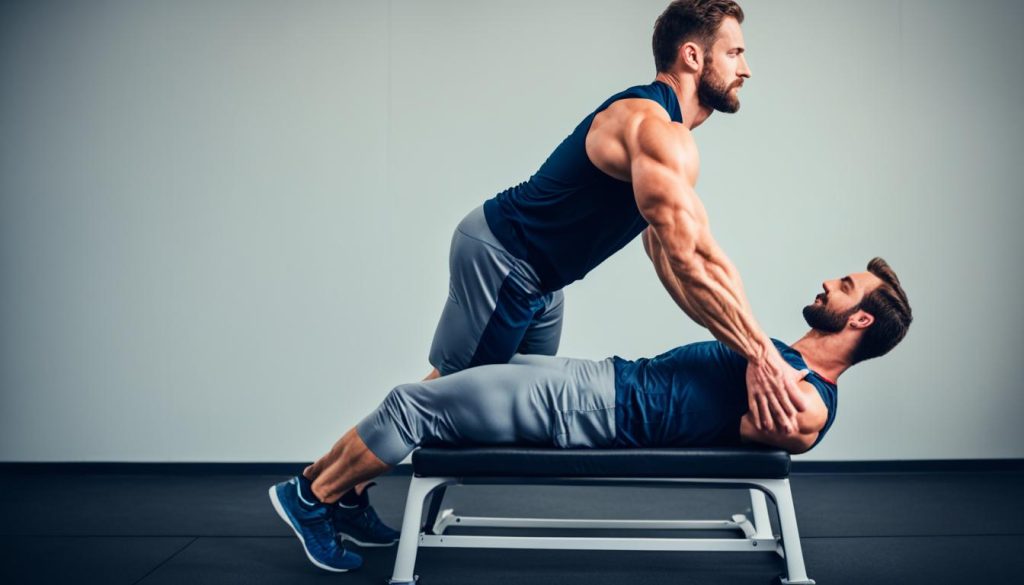
Adding Weights: When and How to Use Dumbbells
Adding dumbbells to your workout at home can really boost your muscle gain. These tools are great for weight lifting at home and work out many muscle groups. Start with lighter weights and focus on proper form before moving to heavier ones.
Incorporating Dumbbells into Your Routine
First, figure out your fitness level and pick the right dumbbell weight. Beginners should start with weights between 5 to 20 pounds. Try to do dumbbell training 2 to 3 times a week, focusing on different muscle groups. Make a plan that includes exercises for both the upper and lower body.
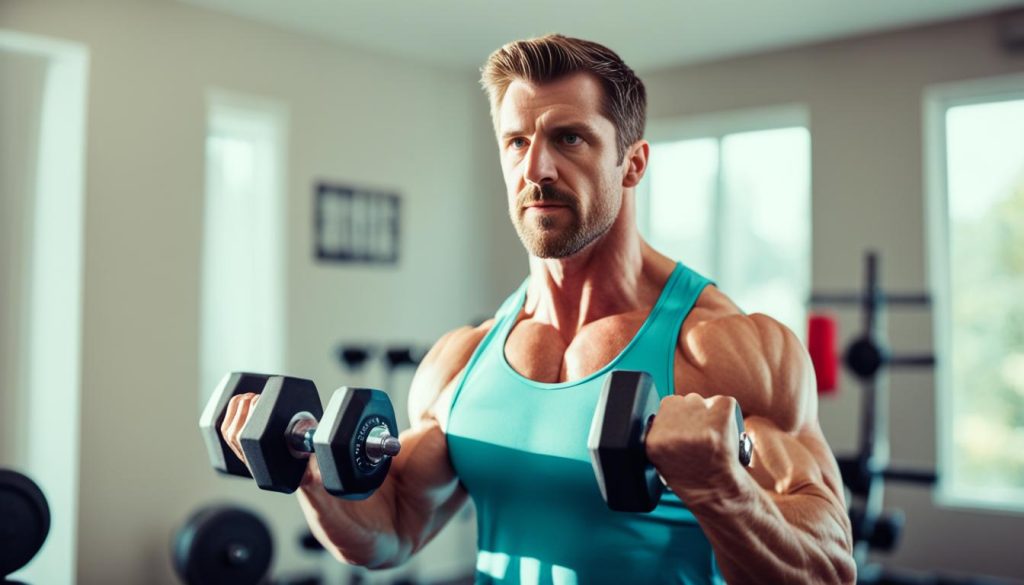
Effective Dumbbell Exercises for Muscle Gains
- Dumbbell Chest Press: Great for building strength in your chest and triceps.
- Dumbbell Rows: Focuses on improving back strength and muscle definition.
- Overhead Press: Targets shoulders and enhances overall stability.
- Bicep Curls: A classic dumbbell exercise that effectively isolates the biceps.
- Goblet Squats: Combines lower body and core work for muscle gain.
Set up these exercises into circuits to make your at-home workouts more effective. Remember, consistency and patience are key as muscle growth takes time. Adjust the weights as you get stronger to keep challenging yourself.
The Role of Cardio in Strength Training
Adding cardio and strength training to your routine boosts your fitness level. Experts say you should do at least 150 minutes of moderate-intensity aerobic exercise weekly. This mix helps your heart health and grows your muscles.
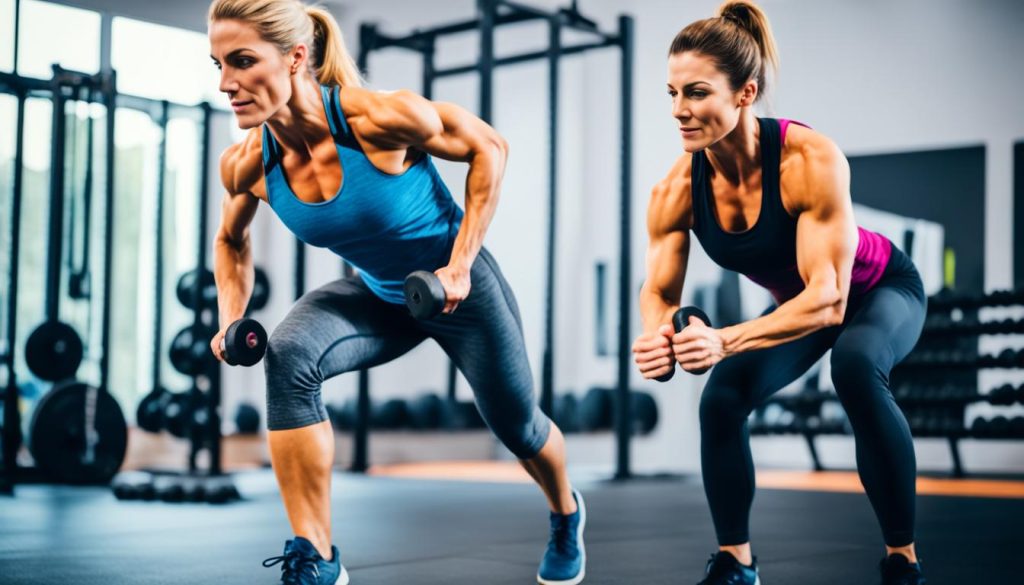
A 2009 study found that 20-minute cardio sessions boost your immune system. They increase white blood cell production. This shows how vital aerobic exercise is for staying healthy, which goes hand in hand with strength training.
Studies also show that mixing HIIT with strength exercises works well. Just 20 minutes of strength training, five days a week, can lead to great results. A recent study found that 15 to 20 minutes of weight training three times a week can also make your bones stronger.
- Lower body circuit and core exercises on Monday, Wednesday, and Friday.
- Upper body circuit and core exercises on Tuesday, Thursday, and Saturday.
- Dedicated core exercises on Sunday.
Combining aerobic and HIIT workouts with strength training helps burn fat and speeds up your metabolism. This mix supports muscle growth, aids in losing weight, and reduces anxiety. Keeping a balance between cardio and strength workouts improves both your body and mind.
Creating a Balanced At-Home Workout Routine
Creating a balanced workout routine at home can boost muscle growth and fitness. There are two main ways to structure your workouts: full-body workouts and split training. Each method has its own benefits, depending on your fitness goals and time.
Full-Body Workouts vs. Split Training
Full-body workouts hit all major muscle groups in one session. They’re great for beginners or those short on time. You can do exercises like bodyweight squats, push-ups, and lunges in 2 to 3 sessions a week.
Split training focuses on certain muscle groups in each session, spreading them out over the week. It’s good for those with more experience or specific goals. For example, you might do upper body workouts one day and lower body workouts the next, targeting muscles better.
Weekly Workout Structure for Optimal Muscle Building
A well-planned workout schedule helps you get the most out of your time and prevents overtraining. Here’s a weekly plan to think about:
- Monday: Full-body workout (Beginner circuit: Bodyweight squats, Push-ups, Walking lunges)
- Wednesday: Upper body split (Dumbbell rows, Planks, Push-ups)
- Friday: Lower body split (One-legged squats, Walking lunges, Jump step-ups)
For those more advanced, try circuits like the Advanced Bodyweight Workout or exercises from the Batman No-Equipment Workout. These add variety and intensity. Always rest for 48 hours between sessions on the same muscle groups to help with recovery.
Progressive Overload: The Key to Continued Growth
Progressive overload is key for muscle growth and strength. It means slowly adding more weight or reps to your workouts. This keeps your body challenged and helps avoid hitting a plateau.
Increasing Reps, Sets, or Time
Try adding more reps, sets, or workout time to boost your progress. Aim to increase the load by 10% each week. This slow increase helps your body adapt safely and prevents injuries.
For strength training, doing more reps can improve muscle endurance. This supports your fitness goals.
Variations and Modifications for Progressive Overload
Changing your exercises can help with progressive overload. You might switch up the type of exercises or increase their intensity. Cardio workouts can get harder with interval training, boosting fitness and endurance.
Warm-ups and proper form are key to safely increasing the intensity. Working with a certified trainer ensures you’re progressing safely and effectively.
Remember, progress isn’t just about lifting heavier. Focus on perfecting your form and techniques, especially if you’re new to working out. Include deload weeks and listen to your body to keep making progress safely and sustainably.
How to Maximize Recovery for Muscle Gains
For anyone wanting to boost their muscle gains, recovery is key. Training is crucial, but so are rest days. These days let your body heal, adapt, and get stronger. A good recovery plan helps prevent injuries and keeps muscles healthy.
Getting enough sleep is a big part of recovery. Try to sleep 7-9 hours each night to help your body fix itself.
- Active recovery like light walking or yoga helps with blood flow and speeds up healing.
- Stretching after a workout helps with flexibility and can lessen soreness.
- Good nutrition is also key. Eating about 1.6 grams of protein per kilogram of body weight daily helps muscles repair.
Drinking enough water is also vital for recovery. Not drinking enough can slow down muscle repair. It’s best to drink 1.5 liters of water for every kilogram you lost while exercising. Foods like cherry juice eaten before a workout can also help with recovery.
Supplements like creatine monohydrate can help too. They boost muscle strength and recovery when used with weight training. Other things like compression clothes or massages might also make you feel better faster.
Using a mix of recovery methods will help you build muscle better. It gets you ready for your next workout with more strength and energy.
Nutrition Tips to Support Muscle Building at Home
Nutrition is key for building muscles, especially when working out at home. Eating the right foods helps with muscle repair and growth. Knowing how much protein you need and staying hydrated can make your workouts better and help you recover faster.
Importance of Protein for Muscle Repair
Protein is crucial for fixing and growing muscles. Studies show eating 1.4 to 2 grams of protein per kilogram of body weight daily is best for muscle growth. Foods high in protein like chicken and tuna are great after working out. Tuna, for example, has almost 20 grams of protein per 3-ounce serving and is packed with vitamins.
Lean meats like pork tenderloin and beef are also good for muscles, giving you about 23 grams of protein each.
- High-protein snacks like low-fat cottage cheese provide about 28 grams of protein per cup.
- Shrimp is another ideal source, delivering 19 grams of protein in 3 ounces.
- Soybeans offer healthy unsaturated fats alongside 16 grams of protein per half cup.
If you can’t get enough protein from food, consider protein powders made from whey or plants. Spreading out your protein intake throughout the day helps with muscle growth.
Hydration: Fueling Your Workouts
Hydration is just as important as nutrition for muscle building. It helps you perform well during workouts and recover better. Not drinking enough water can make you tired and stop muscle growth. It’s important to stay hydrated to keep going strong and make the most of your workouts.
Drink water before, during, and after your workouts. Keep drinking fluids all day to help with hydration and performance. With the right nutrition and hydration, you’ll have more energy, train better, and recover faster.
Incorporating High-Intensity Interval Training (HIIT)
High-intensity interval training (HIIT) is key for building muscle and boosting aerobic fitness. It involves *short bursts of intense activity* with rest periods. These periods can last from 15 seconds to several minutes. HIIT lets you work out quickly and is great for those who say they don’t have enough time, as noted by the CDC.
Adding HIIT to your routine can greatly improve muscle mass and metabolism. Even *20 to 30 minutes* of HIIT can bring big results for those in good shape. After these workouts, your metabolism stays high for hours, known as excess post-exercise oxygen consumption (EPOC). This effect is better than jogging or weight training, making HIIT a top choice for building muscle.
For better aerobic fitness, try work-to-rest ratios of 1:1 or 1:2. This means focusing on high-intensity efforts. HIIT can also focus on anaerobic training, boosting power with longer rest times. This flexibility makes HIIT suitable for all fitness levels and goals.
Studies show that mixing strength training with HIIT leads to more fat loss and muscle retention. This combo also improves health markers like blood pressure and blood sugar. So, doing HIIT not only aids in *significant fat loss* but also boosts overall health.
For those wanting to try HIIT at home, using resistance bands or weights can make the workout tougher. Focus on proper form and recovery to safely enjoy HIIT’s benefits. This way, you can build muscle and improve your fitness at home.
Common Mistakes to Avoid When Training at Home
Working out at home can lead to mistakes that slow down your progress. It’s key to focus on proper workout form and understand how recovery is important. Knowing what mistakes to avoid can greatly improve your fitness journey.
Neglecting Form for the Number of Reps
Many at-home exercisers ignore their form to just do more reps. Studies show that about 65% of people don’t use their core right, leading to muscle strain and less effective workouts. They often use their quads too much in exercises like squats and lunges, missing out on glutes and hamstrings.
This imbalance stops muscle growth in those areas and can cause muscle imbalances. Also, around 45% of people round their shoulders during weight exercises, which raises injury risks. Using correct technique with lighter weights is better than lifting heavy with bad form.
Ignoring Rest and Recovery Days
Many people don’t see the value in rest days, thinking more intense workouts are always better. But overworking muscles without enough rest can cause a lot of soreness or injuries, hitting about 70% of home exercisers. Overtraining can lead to chronic injuries, especially with random workout plans without balance.
Rest days are key for muscle recovery. Doing strength training two to three times a week is enough for building strength and muscle. Balanced workouts that include both pushing and pulling exercises help keep muscles even, reducing injury risks and imbalances.
Conclusion
Building muscle at home is totally doable. You can use your own body weight, items from your house, or cheap tools like resistance bands. This means you can start your fitness journey even if gyms are closed or you’re on a tight budget.
Creating a workout plan that covers all your muscles is key. For example, do push-ups for your chest and squats for your legs. Remember, sticking to a routine, eating right, and resting well are crucial for growing muscles and staying strong.
Remember, getting stronger at home is a journey. Plan your workouts well, challenge yourself, and focus on doing exercises correctly. With hard work and the right strategy, you’ll see big improvements in your strength and fitness from home.
FAQ
Can I really build muscle at home without joining a gym?
Yes, you can build muscle at home with bodyweight exercises and a few dumbbells. A well-planned workout routine with strength training can help you grow muscles. It also boosts your overall fitness.
What is the optimal frequency for strength training to promote muscle growth?
Doing strength workouts at least twice a week is best for muscle growth. This helps improve body composition, boosts your metabolism, and supports your health.
How does muscle hypertrophy occur during strength training?
Muscle growth happens through three main ways: mechanical tension from resistance, muscle damage from tiny injuries, and metabolic stress from hard workouts. These create an environment that helps muscles build.
What are some effective bodyweight exercises I can do at home?
Great exercises for muscle growth include push-ups for the chest and triceps, squats for the lower body, and pull-ups for the back and biceps. These exercises can be adjusted for different skill levels.
When should I start adding dumbbells to my home workout routine?
Add dumbbells to your routine after you’re comfortable with bodyweight exercises and want to boost your strength training. Dumbbell exercises like chest presses and rows can greatly help muscle growth.
What is the importance of cardio alongside strength training?
Cardio training keeps your heart healthy, aids in recovery, and burns calories. High-Intensity Interval Training (HIIT) combines aerobic and anaerobic efforts. This type of training helps build muscles through metabolic stress.
How can I create a balanced workout routine at home?
Plan your workouts with full-body exercises for overall gains or focus on specific muscle groups. Make a weekly schedule with the right amount of exercises and frequency based on your fitness level.
What does progressive overload mean and why is it important?
Progressive overload means gradually increasing the challenge to your muscles over time. You can do this by adding more reps, sets, or workout time. It’s key for muscle growth and avoiding fitness plateaus.
How critical is recovery in the muscle-building process?
Recovery is key as it lets muscles repair and grow after workouts. Include rest days, focus on sleep, use active recovery, and stretch often to improve muscle recovery and performance.
How does nutrition impact muscle building while training at home?
Good nutrition is crucial for muscle repair and growth. You need enough protein, depending on your goals. Also, staying hydrated and eating the right foods before and after workouts can boost your performance and recovery.
What common mistakes should I avoid when training at home?
Don’t sacrifice proper form for more reps, as it can lead to injuries. Also, skipping rest and recovery days can slow your progress, causing burnout or overtraining.


